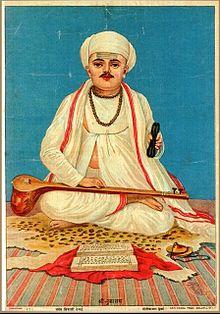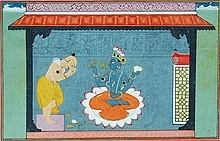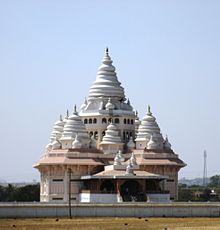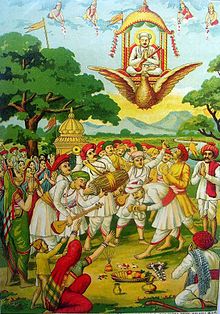Tukaram
For the 1936 Marathi film, see Sant Tukaram (film). For the 1963 Kannada film, see Santha Thukaram. For the 2012 Marathi film, see Tukaram (film). For the 1938 Tamil film, see Thukkaram.
|
Sant Tukaram
संत तुकाराम |
|
|---|---|

Sant Tukaram
|
|
| Personal | |
| Born |
Either 1598 or 1608
[1]
[2]
Dehu, near Pune [2] Maharashtra, India |
| Died | Either 1649 or 1650 in Dehu |
| Religion | Hinduism |
| Known for |
Abhanga devotional poetry, Marathi poet-sant of Bhakti movement [3] |
| Order | Varkari tradition |
| Religious career | |
| Guru | Babaji Chaitanya |
| Literary works | Tukaram Gatha |
| Part of a series on | |
| Hindu philosophy | |
|---|---|

|
|
| Orthodox | |
|
|
| Heterodox | |
|
|
|
Sub-schools
|
|
|
Teachers (Acharyas)
|
|
|
Major texts
|
|
|
|
| Part of a series on |
| Vaishnavism |
|---|

|
|
Supreme deity
|
|
Important deities
|
|
Holy scriptures
|
|
Sampradayas
|
|
Teachers–acharyas
|
|
Related traditions
|
|
|
Sant Tukaram Maharaj also referred to as Santshreshta, Jagadguru, Tukoba and Tukobaraya, [4] was a 17th-century Hindu poet and sant of the Bhakti movement in Maharashtra, India. [2] [3] He was part of the egalitarian, personalized Varkari devotionalism tradition. [5] Sant Tukaram Maharaj is best known for his devotional poetry called Abhanga and community-oriented worship with spiritual songs known as kirtans. [5] His poetry was devoted to Vitthala or Vithoba.
Tukaram was born in modern day Maharastra state of India. His complete name was Tukaram Bolhoba Ambile. The year of birth and death of sant Tukaram has been a subject of research and dispute among 20th-century scholars. [6] [7] He was either born in the year 1598 or 1608 in a village named Dehu, near Pune in Maharashtra, India. [2] [7]
Sant Tukaram was born to Kanakar and Bolhoba More and scholars consider his family to belong to the Kunbi [8] caste. Tukaram's family owned a retailing and money-lending business as well as were engaged in agriculture and trade. [3] [7] His parents were devotees of Vithoba, an avatar of Hindu deity Vishnu (Vaishnavas). Both his parents died when Tukaram was a teenager. [7]
Sant Tukaram's first wife was Rakhama Bai, and they had a son named Santu. [9] However, both his son and wife starved to death in the famine of 1630–1632. [3] [10] The deaths and widespread poverty had a profound effect on Tukaram, who became contemplative, meditating on the hills of Sahyadri range (Western Ghats) and later wrote he "had discussions with my own self". [3] [9] Tukaram married again, and his second wife was Avalai Jija Bai. [3] [9] He spent most of his later years in devotional worship, community kirtans (group prayers with singing) and composing Abhanga poetry. [3] [9]
id=ZOWIAwAAQBAJ&pg=PP6|publisher=SUNY Press|isbn=978-1-4384-1687-8|pages=9–11|date=January 1994}} [11] In his work of Abhangas, Tukarama repeatedly refers to four other persons who had a primary influence on his spiritual development, namely the earlier Bhakti Sants Namdev, Dnyaneshwar, Kabir and Eknath. [12]
According to some scholars, Tukaram met Chatrapati Shivaji Maharaj – a leader who challenged the Mughal Empire and founded the Maratha kingdom;(Hindvi Swarajya) [13] [14] [9] [15] Their continued interaction is the subject of legends. [15] [16] Eleanor Zelliot states that Bhakti movement poets including Tukaram were influential in Shivaji's rise to power. [11]
Tukaram disappeared (not died) in 1649 or 1650. [2] [17]
Important Places associated with Tukaramji in Dehu that exist today are:
- Tukaram Maharaj Janm Sthan Temple, Dehu – place where Tukaramji was born, around which a temple was built later
- Sant Tukaram Vaikunthstan Temple, Dehu – from where Tukaramji ascended to Vaikunth in his mortal form[citation needed]; there is a nice ghat behind this temple along the Indrayani river
- Sant Tukaram Maharaj Gatha Mandir, Dehu – modern structure; massive building housing a big statue of Tukaram; In the Gatha temple, about 4,000 abhangs (verses) created by Tukaram maharaj were carved on the walls. [18]
Literary works
Sant Tukaram composed Abhanga poetry, a Marathi genre of literature which is metrical (traditionally the ovi meter), simple, direct, and it fuses folk stories with deeper spiritual themes.
Tukaram's work is known for informal verses of rapturous abandon in folksy style, composed in vernacular language, in contrast to his predecessors such as Dnyandeva or Namdev known for combining similar depth of thought with a grace of style. [19]
In one of his poems, Tukaram self-effacingly described himself as a "fool, confused, lost, liking solitude because I am wearied of the world, worshipping Vitthal (Vishnu) just like my ancestors were doing but I lack their faith and devotion, and there is nothing holy about me". [20]
Tukaram Gatha is a Marathi language compilation of his works, likely composed between 1632 and 1650. [19] Also called Abhanga Gatha, the Indian tradition believes it includes some 4,500 abhangas, but modern scholars have questioned the authenticity of most of them. [19] The poems considered authentic cover a wide range of human emotions and life experiences, some autobiographical, and places them in a spiritual context. [19] He includes a discussion about the conflict between Pravritti – having passion for life, family, business, and Nivritti – the desire to renounce, leave everything behind for individual liberation, moksha. [19]
Ranade states there are four major collations of Tukaram's Abhanga Gathas. [21]
Authenticity
Numerous inconsistent manuscripts of Tukaram Gatha are known, and scholars doubt that most of the poems attributed to Tukaram are authentic. [19] Of all manuscripts so far discovered, four are most studied and labelled as: the Dehu MS, the Kadusa MS, the Talegeon MS and the Pandharpur MS. [22] Of these, the Dehu MS is most referred to because Indian tradition asserts that it is based on the writing of Tukaram's son Mahadeva, but there is no historical evidence that this is true. [22]
The first compilation of Tukaram poems was published, in modern format, by Indu Prakash publishers in 1869, subsidized by the British colonial government's Bombay Presidency. [22] The 1869 edition noted, "some of the [as received] manuscripts on which the compilation relied, had been 'corrected', 'further corrected' and 'arranged'." [22] This doctoring and rewriting over about 200 years, after Tukaram's death, has raised questions whether the modern compilation of Tukaram's poems faithfully represents what Tukaram actually thought and said, and the historicity of the document. The known manuscripts are jumbled, randomly scattered collections, without chronological sequence, and each contains some poems that are not found in all other known manuscripts. [23]
Philosophy and practices
Early 20th-century scholars on Tukaram considered his teachings to be Vedanta-based but lacking a systematic theme. Edwards wrote,
Tukaram is never systematic in his psychology, his theology, or his theodicy. He oscillates between a Dvaitist [Vedanta] and an Advaitist view of God and the world, leaning now to a pantheistic scheme of things, now to a distinctly Providential, and he does not harmonize them. He says little about cosmogony, and according to him, God realizes Himself in the devotion of His worshippers. Likewise, faith is essential to their realization of Him: 'It is our faith that makes thee a god', he says boldly to his Vithoba.
— JF Edwards (1921), Encyclopædia of Religion and Ethics, Volume 12 [24]
Late 20th-century scholarship of Tukaram, and translations of his Abhanga poem, affirm his pantheistic Vedantic view. [25] Tukaram's Abhanga 2877, as translated by Shri Gurudev Ranade of Nimbal states, for example, "The Vedanta has said that the whole universe is filled by God. All sciences have proclaimed that God has filled the whole world. The Puranas have unmistakably taught the universal immanence of God. The sants have told us that the world is filled by God. Tuka indeed is playing in the world uncontaminated by it like the Sun which stands absolutely transcendent". [25]
Scholars note the often discussed controversy, particularly among Marathi people, whether Tukaram subscribed to the monistic Vedanta philosophy of Adi Shankara. [26] [27] Bhandarkar notes that Abhanga 300, 1992 and 2482 attributed to Tukaram are in style and philosophy of Adi Shankara: [26]
When salt is dissolved in water, what is it that remains distinct? I have thus become one in joy with thee [Vithoba, God] and have lost myself in thee. When fire and camphor are brought together, is there any black remnant left? Tuka says, thou and I are one light.
— Tukaram Gatha, 2482, Translated by RG Bhandarkar [26]
However, scholars also note that other Abhangas attributed to Tukaram criticize monism, and favor dualistic Vedanta philosophy of the Indian philosophers Madhvacharya and Ramanuja. [26] In Abhanga 1471, according to Bhandarkar's translation, Tukaram says, "When monism is expounded without faith and love, the expounder as well as the hearer are troubled and afflicted. He who calls himself Brahma and goes on in his usual way, should not be spoken to and is a buffoon. The shameless one who speaks heresy in opposition to the Vedas is an object of scorn among holy men." [26]
The controversy about Tukaram's true philosophical positions has been complicated by questions of authenticity of poems attributed to him, discovery of manuscripts with vastly different number of his Abhang poems, and that Tukaram did not write the poems himself, they were written down much later, by others from memory. [28]
Tukaram denounced mechanical rites, rituals, sacrifices, vows and instead encouraged direct form of bhakti (devotion). [26] [29]
Kirtan
Tukaram encouraged kirtan as a music imbued, community-oriented group singing and dancing form of bhakti. [5] He considered kirtan not just a means to learn about Bhakti, but Bhakti itself. [5] The greatest merit in kirtan, according to Tukaram, is it being not only a spiritual path for the devotee, it helps create a spiritual path for others. [30]
Social reforms
Tukaram accepted disciples and devotees without discriminating gender. One of his celebrated devotees was Bahina Bai, a Brahmin woman, who faced anger and abuse of her husband when she chose Bhakti marga and Tukaram as her guru. [31]
Tukaram taught, states Ranade, [32] that "pride of caste never made any man holy", "the Vedas and Shastras have said that for the service of God, castes do not matter", "castes do not matter, it is God's name that matters", and "an outcast who loves the Name of God is verily a Brahmin; in him have tranquility, forbearance, compassion and courage made their home". [32] However, early 20th century scholars questioned whether Tukaram himself observed caste when his daughters from his second wife married men of their own caste. [33] Fraser and Edwards, in their 1921 review of Tukaram, stated that this is not necessarily so, because people in the West too generally prefer relatives to marry those of their own economic and social strata. [33]
David Lorenzen states that the acceptance, efforts and reform role of Tukaram in the Varakari-sampraday follows the diverse caste and gender distributions found in Bhakti movements across India. [34] Tukaram, of Shudra varna, was one of the nine non-Brahmins, of the twenty one considered sant in Varakari-sampraday tradition. [34] The rest include ten Brahmins and two whose caste origins are unknown. [34] Of the twenty one, four women are celebrated as sant, born in two Brahmin and two non-Brahmin families. Tukaram's effort at social reforms within Varakari-sampraday must be viewed in this historical context and as part of the overall movement, states Lorenzen. [34]
Legacy
 Gatha temple in Dehu, near Pune Maharashtra, is one of two local temples that mark the legacy of Tukaram. His poetry is carved on its wall.
[35]
Gatha temple in Dehu, near Pune Maharashtra, is one of two local temples that mark the legacy of Tukaram. His poetry is carved on its wall.
[35]
Tukaram was a devotee of Vitthala or Vithoba, an avatar of God Vishnu, synchronous with Krishna but with regional style and features. [11] Tukaram's literary works, along with those of sants Dnyandev, Namdev and Eknath, states Mohan Lal, are credited to have propelled Varkari tradition into pan-Indian Bhakti literature. [36]
According to Richard Eaton, from early 14th-century when Maharashtra region came under the rule of the Delhi Sultanate, down to the 17th-century, the legacy of Tukaram and his poet-predecessors, "gave voice to a deep-rooted collective identity among Marathi-speakers". [37] Dilip Chitre summarizes the legacy of Tukaram and Bhakti movement sants, during this period of Hindu-Muslim wars, as transforming "language of shared religion, and religion a shared language. It is they who helped to bind the Marathas together against the Mughals on the basis not of any religious ideology but of a territorial cultural identity". [38]
Mahatma Gandhi, in early 20th century, while under arrest in Yerwada Central Jail by the British colonial government for his non-violent movement, read and translated Tukaram's poetry along with Upanishads, Bhagavad Gita and poems by other Bhakti movement poet-sants. [39]
Saintliness is not to be purchased in shops, nor is it to be had for wandering, nor in cupboards, nor in deserts, nor in forests. It is not obtainable for a heap of riches. It is not in the heavens above, nor in the entrails of the earth below. Tuka says: It is a life's bargain, and if you will not give your life to possess it, better be silent.
The essence of the endless Vedas is this: Seek the shelter of God and repeat His name with all thy heart. The result of the cogitations of all the Shastras is also the same. Tuka says: The burden of the eighteen Puranas is also identical.
Merit consists in doing good to others, sin in doing harm to others. There is no other pair comparable to this. Truth is the only freedom; untruth is bondage, there is no secret like this. God's name on one's lips is itself salvation, disregarding the name is perdition. Companionship of the good is the only heaven, indifference is hell. Tuka says: It is thus clear what is good and what is injurious, let people choose what they will.
— Sant Tukaram, Translated by Mahatma Gandhi [39]
Sant Tukaram also had a profound influence on K. B. Hedgewar as the former's quotes often found their way on the latter's letterhead. One such letter dated April 6th 1940 bore the quote "Daya tiche nanwa bhutanche palan, aanik nirdalan kantkache", meaning compassion is not only the welfare of all living beings, but also includes protecting them from harm’s way. [40]
Films and popular literature
 Tukaram leaves for Vaikuntha, Supreme Abode of God Vishnu.
Tukaram leaves for Vaikuntha, Supreme Abode of God Vishnu.
- Sant Tukaram (1936) – this movie on Tukaram was screened open-air for a year, to packed audiences in Mumbai, and numerous rural people would walk very long distances to see it. [41]
- Santha Thukaram (1963) in Kannada
- Sant Tukaram (1965) in Hindi
- Bhakta Tukaram (1973) in Telugu
- Tukaram (2012) in Marathi
Tukaram's life was the subject of 68th issue of Amar Chitra Katha, India's largest comic book series. [42]
Government of India Issued 100 rupees Silver commemorative coin in 2002. [43]
Books and translations of Sant Tukaram
The 18th-century biographer Mahipati, in his four volume compilation of the lives of many Bhakti movement sants, included Tukaram. Mahipati's treatise has been translated by Justin Abbott. [11] [44]
A translation of about 3,700 poems from Tukaram Gatha in English was published, in three volumes, between 1909 and 1915, by Fraser and Marathe. [45] In 1922, Fraser and Edwards published his biography and religious ideas incorporating some translations of Tukaram's poems, [46] and included a comparison of Tukaram's philosophy and theology with those of Christianity. [47] Deleury, in 1956, published a metric French translation of a selection of Tukaram's poem along with an introduction to the religious heritage of Tukaram (Deleury spells him as Toukaram). [48]
Arun Kolatkar published, in 1966, six volumes of avant-garde translations of Tukaram poems. [11] Ranade has published a critical biography and some selected translation. [49]
Dilip Chitre translated writings of Sant Tukaram into English in the book titled Says Tuka for which he was awarded the Sahitya Akademi award in 1994. [23] A selection of poems of Tukaram has been translated and published by Daniel Ladinsky. [50]
Chandrakant Kaluram Mhatre has translated selected poems of Tukaram, published as One Hundred Poems of Tukaram. [51]
See also
- Bhakti movement
- Pandharpur Wari – the largest annual pilgrimage in Maharashtra that includes a ceremonial Palkhi of Tukaram
- Vitthal Temple, Pandharpur
References
- RD Ranade (1994), Tukaram, State University of New York Press, ISBN 978-0791420928 , pages 3-7
- SG Tulpule (1992), Devotional Literature in South Asia (Editor: RS McGregor), Cambridge University Press, ISBN 978-0521413114 , page 148
- Mohan Lal (1993), Encyclopedia of Indian Literature: Sasay to Zorgot, Sahitya Akademi, South Asia Books, ISBN 978-9993154228 , pages 4403-4404
- Maxine Bernsten (1988), The Experience of Hinduism: Essays on Religion in Maharashtra, State University of New York Press, ISBN 978-0887066627 , pages 248-249
- Anna Schultz (2012), Singing a Hindu Nation: Marathi Devotional Performance and Nationalism, Oxford University Press, ISBN 978-0199730834 , page 26
- RD Ranade (1994), Tukaram, State University of New York Press, ISBN 978-0791420928 , pages 1-7
- Richard M. Eaton (2005), A Social History of the Deccan, 1300–1761: Eight Indian Lives, Cambridge University Press, ISBN 978-0521716277 , pages 129-130
- Palgrave Macmillan, ed. (2002). Challenging Subjects: Critical Psychology for a New Millennium. p. 119. "Tukaram thanks God for his having been born a kunbi (a farming caste) and not, by implication, as every commentator agrees, a brahmin"
- RD Ranade (1994), Saint Tukaram, State University of New York Press, ISBN 978-0791420928 , pages 7-9
- SG Tulpule (1992), Devotional Literature in South Asia (Editor: RS McGregor), Cambridge University Press, ISBN 978-0521413114 , pages 150-152
- Eleanor Zelliot (1976), Hinduism: New Essays in the History of Religions (Editor: Bardwell L Smith), Brill Academic, ISBN 978-9004044951 , pages 154-156
- RD Ranade (1994), Tukaram, State University of New York Press, ISBN 978-0791420928 , pages 10-12
- Stewart Gordon (1993). The Marathas 1600–1818 . Cambridge University Press. pp. 1–3. ISBN 978-0-521-26883-7 .
- Kaushik Roy (2015). Warfare in Pre-British India – 1500BCE to 1740CE . Routledge. pp. 140–141. ISBN 978-1-317-58692-0 .
- Justin Edwards Abbott (2000), Life of Tukaram, Motilal Banarsidass, ISBN 978-8120801707 , page 320
- SG Tulpule (1992), Devotional Literature in South Asia (Editor: RS McGregor), Cambridge University Press, ISBN 978-0521413114 , pages 158-163
- RD Ranade (1994), Tukaram, State University of New York Press, ISBN 978-0791420928 , pages 1-2
- "Gatha Mandir" .
- Mohan Lal (1993), Encyclopaedia of Indian Literature: Sasay to Zorgot, Sahitya Akademi, South Asia Books, ISBN 978-9993154228 , pages 4404-4405
- SG Tulpule (1992), Devotional Literature in South Asia (Editor: RS McGregor), Cambridge University Press, ISBN 978-0521413114 , pages 149-150
- RD Ranade (1994), Tukaram, State University of New York Press, ISBN 978-0791420928 , pages 19-22
- The Life and Teaching of Tukaram J Nelson Fraser, and JF Edwards, Probsthain, Christian Literature Society, pages 119-124
- Dilip Chitre (1991), Says Tuka: Selected Poetry of Tukaram, Penguin, ISBN 978-0140445978
- JF Edwards (1921), Encyclopædia of Religion and Ethics: Suffering-Zwingli , Volume 12, Editors: James Hastings, John Alexander Selbie and Louis Herbert Gray, New York: Charles Scribner, Reprinted in 2000 as ISBN 978-0567065124 , page 468
- RD Ranade (1994), Tukaram, State University of New York Press, ISBN 978-0791420928 , pages 192-197
- R G Bhandarkar (2014), Vaisnavism, Saivism and Minor Religious Systems, Routledge, ISBN 978-1138821064 , pages 98-99
- Charles Eliot (1998), Hinduism and Buddhism: An Historical Sketch, Volume 2, Routledge, ISBN 978-0700706792 , page 258, Quote: "Maratha critics have discussed whether Tukaram followed the monistic philosophy of Sankara or more, and it must be confessed that his utterances are contradictory."
- The Life and Teaching of Tukaram J Nelson Fraser, and JF Edwards, Probsthain, Christian Literature Society, pages 119-123, 218-221
- David Lorenzen (2006), Who Invented Hinduism: Essays on Religion in History, Yoda Press, ISBN 978-8190227261 , page 130
- Anna Schultz (2012), Singing a Hindu Nation: Marathi Devotional Performance and Nationalism, Oxford University Press, ISBN 978-0199730834 , pages 25-28
- Anne Feldhaus (1982), BahināBāī: Wife and Saint, Journal of American Academy of Religion, Volume L, Issue 4, pages 591-604
- RD Ranade (1994), Tukaram, State University of New York Press, ISBN 978-0791420928 , pages 154-156
- The Life and Teaching of Tukaram J Nelson Fraser, and JF Edwards, Probsthain, Christian Literature Society, pages 163, 54-55
- David Lorenzen (2006), Who Invented Hinduism: Essays on Religion in History, Yoda Press, ISBN 978-8190227261 , pages 127-128
- Gatha Temple , National Geographic (2014)
- Mohan Lal (1993), Encyclopaedia of Indian Literature: Sasay to Zorgot, Sahitya Akademi, South Asia Books, ISBN 978-9993154228 , page 4403
- Richard M. Eaton (2005), A Social History of the Deccan, 1300–1761: Eight Indian Lives, Cambridge University Press, ISBN 978-0521716277 , pages 138-141
- Dilip Chitre (1991), Says Tuka: Selected Poetry of Tukaram, Penguin, ISBN 978-0140445978 , pages xvi-xvii
-
MK Gandhi (1930), Songs from prison: translations of Indian Lyrics made in Jail, (Adapted and formatted by John Hoyland, 1934),
New York : Macmillan,
OCLC 219708795 - Sunil Ambekar (2019). The RSS: roadmaps for the 21st century . New Delhi: Rupa. p. 19. ISBN 9789353336851 .
- Prem Choudhary (2000), Colonial India and the Making of Empire Cinema, Manchester University Press, ISBN 978-0719057250 , page 155
- Lawrence Babb and Susan Wadley (1998), Media and the Transformation of Religion in South Asia, Motilal Banarsidass, ISBN 978-8120814530 , page 131
- 100 rupees coin of 2002 – Sant Tukaram, https://www.youtube.com/watch?v=eiTy99JkIUU
- Justin Abbott (2000), Tukaram: The Poet-Saints of Maharashtra, Motilal Banarsidass, ISBN 978-8120801707
- J Nelson Fraser and KB Marathe, The Poems of Tukaram, Motilal Banarsidass, ISBN 978-8120808515
- The Life and Teaching of Tukaram J Nelson Fraser, and JF Edwards, Probsthain, Christian Literature Society
- The Life and Teaching of Tukaram J Nelson Fraser, and JF Edwards, Probsthain, Christian Literature Society, pages 274-278, Appendix II & III
- Guy A Deleury (1956), Psaumes dy Pelerin: Toukaram, Paris: Gallimard, ISBN 978-2070717897 , pages 9-34
- Ramchandra Dattatraya Ranade (1994), Tukaram, State University of New York Press, ISBN 978-0791420928
- Daniel Ladinsky (2002), Love Poems from God, Penguin, ISBN 978-0142196120 , pages 331-352
- Chandrakant Kaluram Mhatre, One Hundred Poems of Tukaram, Createspace, ISBN 978-1512071252
Sources
- Ayyappapanicker, K.; Akademi, Sahitya (1997). Medieval Indian Literature: An Anthology. Sahitya Akademi. ISBN 81-260-0365-0 .
- Ranade, Ramchandra D. (1994). Tukaram. New York: State University of New York Press. ISBN 0-7914-2092-2 .
- "Tryambak Shankar Shejwalkar Nivadak Lekhsangrah" by T S Shejwalkar (collection- H V Mote, Introduction- G D Khanolkar)
Further reading
- John Hoyland (1932), An Indian Peasant Mystic: Translations from Tukaram, London: Allenson, OCLC 504680225
- Wilbur Deming (1932), Selections from Tukaram, Christian Literature Society, OCLC 1922126
- Prabhakar Machwe (1977), Tukaram's Poems, United Writer, OCLC 4497514
- Dilip Chitre (1970), The Bhakta as a Poet: Six Examples from Tukaram's Poetry, Delos: A Journal on and of Translation, Vol. 4, pages 132-136
- Fraser, James Nelson; Rev. JF Edwards (1922). The Life and Teaching of Tukārām . The Christian Literature Society for India, Madras.
- Fraser and Marathe (1915), The Poems of Tukaram, 3 vols, Christian Literature Society OCLC 504680214 , Reprinted in 1981 by Motilal Banarsidass, ISBN 978-8120808515
External links
- Works by or about Tukaram at Internet Archive
- Collected works of Tukaram in Devnagari
- Images, Biography: Tukaram Ram Bapat (2002), Tukaram Online, 14 Indian and 8 foreign languages
- What I Want to Say, Tukaram , Mona van Duyn (1965), Poetry, Vol. 107, No. 2, pages 102-104
- Twenty five poems, Tukaram Prabhakar Machwe (1968), Mahfil, Vol. 5, No. 1/2, pages 61–69
- Translations from Tukaram and other saint-poets , Awad Kolatkar (1982), Journal of South Asian Literature, Vol. 17, No. 1, pages 111-114
